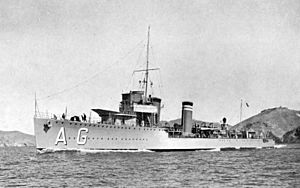Convoy de la Victoria facts for kids
Quick facts for kids Convoy de la Victoria |
|||||||
|---|---|---|---|---|---|---|---|
| Part of the Spanish Civil War | |||||||
 Alcalá Galiano during sea trials |
|||||||
|
|||||||
| Belligerents | |||||||
| Strength | |||||||
| 1 destroyer |
|
||||||
| Casualties and losses | |||||||
| None | None | ||||||
The Convoy de la Victoria (which means "Convoy of Victory") was an important event during the Spanish Civil War. It was a naval battle that happened on August 5, 1936. The battle took place in the Strait of Gibraltar. It was fought between ships supporting the Nationalists and a Republican Navy destroyer called Alcalá Galiano.
Contents
Why Was the Convoy Needed?
In July 1936, the Spanish Civil War had just begun. The rebel forces, known as Nationalists, were in a tough spot. The Republic controlled most of Spain. They had the capital city, most industries, and the country's gold.
The Nationalists' main fighting force was the Spanish Army of Africa. These soldiers were stuck in Spanish Morocco. Most of the Spanish Navy was controlled by the Republic. Republican warships were patrolling the waters between Morocco and mainland Spain. This made it very hard for the Nationalists to move their troops.
Moving Troops by Air
The Nationalists asked for help from Nazi Germany and Fascist Italy. They received transport aircraft. This allowed them to start moving their troops by air. This was the first time in history that soldiers were moved by air in such a large operation.
Germany sent 20 Junkers Ju 52 planes. Between July 29 and August 5, the Nationalists flew about 1,500 soldiers across the Strait. They moved another 15,000 soldiers between August 5 and 15. This air transport was a big boost for the Nationalists. It also caused worry among the Republicans. However, the Republican Navy still controlled the Strait. Their battleship, Jaime I, could threaten the transport planes with its powerful anti-aircraft guns.
The Convoy's Journey
On August 5, 1936, Nationalist leader Francisco Franco decided to try and break the Republican naval blockade. He planned a convoy of merchant ships. These ships were carrying 2,500 to 3,000 soldiers. They also carried military equipment and heavy weapons.
The convoy left Ceuta, a city in Spanish Morocco. It included four transport ships. These ships were protected by a gunboat called Dato. There was also a coastguard ship named Uad Kert. An old torpedo boat, T-19, also helped escort them. Airplanes also provided cover for the convoy. These included five Savoia-Marchetti SM.81 bombers and other fighter planes.
The Battle and Arrival
Three Republican destroyers were watching the ports in Spanish Morocco. But on the morning of August 5, Nationalist planes attacked Republican ships in the Strait. The Republican destroyer Lepanto had to leave the area. This meant only the Alcalá Galiano was left to fight the Nationalist ships.
The convoy was heading for Algeciras. It reached its destination in the evening. There was a short exchange of fire during the journey. While docking in Algeciras, the gunboat Dato accidentally fired near a British destroyer, HMS Basilisk. The Dato had mistaken it for a Republican ship.
As the Alcalá Galiano was sailing back to Málaga, Nationalist aircraft attacked it. The ship was hit. Nationalist reports said that 18 sailors were killed and 28 were wounded.
What Happened Next?
After August 6, transport ships continued to cross the Strait of Gibraltar. Italian bombers provided air cover for them. On August 7, the Republican battleship Jaime I and the cruiser Libertad shelled Algeciras. They badly damaged the Dato and Uad Kert.
However, in the first week of August, a German Junkers Ju 52 plane hit the Republican Jaime I. Italian bombers also started to bother the Republican fleet. This made it harder for them to stop the transport ships. Also, the Republican warships faced challenges with their crews. Two German cruisers, Deutschland and Admiral Scheer, also patrolled the Strait.
The British authorities in Gibraltar and Tangier were not supportive of the Republic. British oil companies in Gibraltar refused to sell fuel to the Republican navy. The Tangier International Commission did not allow the Republican Navy to use the harbor. They said it went against the city's neutrality. However, they did allow food, goods, and fuel for German transport planes to go to Spanish Morocco. By the end of September, the Republic had lost control of the waters between Morocco and the mainland. This happened after the battle of Cape Espartel.
See also
 In Spanish: Convoy de la Victoria para niños
In Spanish: Convoy de la Victoria para niños
- Spanish Civil War Republican ship classes
- List of classes of Spanish Nationalist ships of the Spanish Civil War

